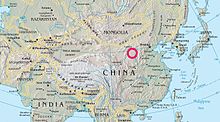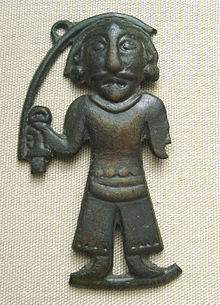This is an old revision of this page, as edited by Per Honor et Gloria (talk | contribs) at 17:07, 3 July 2007 (Reinstated reference and quote). The present address (URL) is a permanent link to this revision, which may differ significantly from the current revision.
Revision as of 17:07, 3 July 2007 by Per Honor et Gloria (talk | contribs) (Reinstated reference and quote)(diff) ← Previous revision | Latest revision (diff) | Newer revision → (diff)
The Ordos culture comprises the period from Upper Paleolithic to the late Bronze age at the Ordos Desert, in the south of the Inner Mongolian Autonomous Region of the People's Republic of China, about 300 kilometers from modern Beijing. The area of the Ordos were predominantly Mongoloid known from their skeletal remains and artifacts, but numerous interactions between Europoid and Mongoloid might had also taken place there over the course of several centuries, until its occupation by Qin and Han dynasties.
Prehistoric people
The Ordos culture is documented from the Upper Palaeolithic. They used the chopping and rock tools of the Zhoukoudian. The points and sides of their tools indicate a "Moustero-Levalloisian" element. They seemed to have a masterful knowledge of Upper Palaeolithic technology, producing blades as much as fifteen centimeters long.
The human fossil remains of the Ordos Man from Salawusu site dated between 50,000 and 35,000 BCE show strong Mongoloid features, specifically on the fore-tooth and occipital bone.
The Zhukaigou culture, is one of the neolithic culture at Ordos, dated between 2200 and 1500 BCE. It contained about 327 burials, recent genetic evidence shown that they were close related to the remains from Yinniugou, as well as modern populations like Daurs and Evenks. The archaeological finds at the site is very similiar to those of the lower Xiajiadian culture. Those finds are important as it was responsible for the development of snake pattern design on the decoration of weapon and depicting animal artifact, known in later as the Ordos style.

The people in Ordos are recorded in the area of the Ordos desert from the 6th century BCE to the 2nd century BCE. What kind of populations occupied the area before them is unclear, but may have been Mongoloid.
The skeletal remains at Taohongbala tomb dated to between 7th century and 6th century BCE are generally identified as belonging to the Xiongnu bronze culture, and show strong Mongoloid features.
A similar type of burial at Hulusitai around Bayannur uncovered in 1979, which is dated to between 5th century to 4th century BCE, is considered as the only Xiongnu's culture situated at the northern slope of Yinshan. The site consisted of mainly bronze artifacts and pottery and 27 horse skeletal remains. Further excavation in 1983 at Guoxianyaozi amounting to a total of 31 burials dated to about 6th century to 5th century BCE, showed strong north Mongoloid. Those features generally decreased towards the south, and skeletal remains of east and north Mongoloid can be seen from the finds in Maoqinggou and Yinniugou dated to around 7th century BCE, which amount to a total of 117 burials. Many bronze weapons of those cultures are similar to those of Chinese style.
Many depictions of the Ordos people tend to have straight hair. Those are especially strong in the archaeological finds at Baotou (M63:22, M63:23, M84:5) Etuoke (M1, M6), Xihaokou (M3), lower Woertuhao (M3:1), and Mengjialiang.
Sakas and Scythians


Later, horse nomads occupied the area from the 6th century BCE to the 2nd century BCE before being driven away by the Xiongnu. They are thought to be the easternmost people of Scythian affinity to have settled here, just to the east of the better-known Yuezhi. They are mainly known from their skeletal remains and artifacts.
They were in contact and often at war with the pre-Han and Han populations of the period. Their former territory is now located just south of the Great Wall of China, and on the south bank of the northernmost hook of the Yellow river.
The people represented in archaeological finds tend to display Europoïd features, and are thought to be of Scythian affinity. The weapons, found in tombs throughout the steppes of the Ordos, are very close to those of the Scythians, especially the Sakas.
The Ordos people manufactured belt plaques, horse gear and weapons depicting animals, often in combat. The "animal-style" is similar to nomadic traditions found in Central Asia, such as that of the Scythians.
Relationships
The eastern neighbours of Ordos may have been identical with the Yuezhi who, after being vanquished by the Xiongnu, migrated to southern Asia to form the Kushan empire. They were also culturally related to another nomadic tribe to the east, the Eastern Hu (Chinese:東胡, "Donghu"), who shared a similar "art of the steppes" but appear to have been Mongoloids.. They may also have been related to the Di people (Chinese:氐 "Western Barbarians") of Chinese annals.
By one account, the area of Ordos was the legendary land of origin of the Turks.
Xiongnu occupation
In Chinese accounts, the Xiongnu first appear at Ordos in the Yizhoushu and Shanhaijing during the Warring States Period before it was occupied by Qin and Zhao. It is generally thought to be their homeland, however when exactly they came to presence is unclear. Although it might had much earlier than traditional thought as suggests from the archaeological finds.
Just as the Xiongnu expanded southward into Yuezhi territory around 160 BCE under their leader Modun, it is thought they also occupied the Ordos area during the same period, when they came in direct contact with the Chinese. From there, the Xiongnu conducted numerous devastating raids into Chinese territory (167, 158, 142, 129 BCE).
The Han dynasty started to fight the Xiongnu in the 2nd century BCE under emperor Han Wudi, and colonized the area of the Ordos under Shuofang commandery in 127 BCE. Prior to the campaign, there were already commanderies established earlier by Qin and Zhao until they were overrun by the Xiongnu in 209 BCE.
Artifacts
Main artifacts of the Ordos people, as displayed in the British Museum (Asian Gallery):
-
Bronze pole top, Ordos, 6th-5thCentury BCE.
-
Silver horse, Ordos, 4th-1st century BCE.
-
Belt buckle, Ordos, 3rd-1st century BCE.
-
Belt buckle, Ordos, 3rd-1st century BCE.
-
 Ordos bronze horses, 5th-3rd century BCE.
Ordos bronze horses, 5th-3rd century BCE.
-
Horse attacked by tiger, Ordos, 4th-1st century BCE.
Notes
- Ma 2005, p. 196-197
- Lebedynsky, p131
- Jacquetta Hawkes and Sir Leonard Woolley, History of Mankind: Volume I. (New York: Harper and Row, 1963), p.172.
- Weiwen, Huang, Salawusu Relic. Encyclopedia of China, 1st ed.
- Mitochondrial DNA analysis of remains from Zhukaigou archaeological site in Inner Mongolia. WANG Hal-jing, CHANG E, CAI Da-wei, ZHANG Quan-chao, ZHOU Hui, ZHU Hong (1. Ancient DNA Laboratory, Research Center for Chinese Frontier Archaeology, Jilin University, Changchun 130012, China: 2. Teaching and Research Center of Chemistry, College of Chemistry, Jilin University, Changchun 130021, China; 3. Macromolecular Laboratory, College of Life Science, Jilin University, Changchun 130023, China). 2007.
- Ma 2005, p. 298-299
- Ma 2005, p. 231
- Wuen, Taohongbala Tombs. Encyclopedia of China, 1st ed.
- Ma 2005, p. 230-231
- Ma 2005, p. 232-233, 278-279
- Ma 2005, p. 282-290
- Ma 2005, p. 188-189
- "The Mongoloid types of the Transbaikal area and Central and Eastern Mongolia are strongly contrasted with the Europoid type displayed at the same time by the Scythian nomads occupying Western Mongolia and their predecessors of the Bronze age". "Les Saces", Lebedinsky, p125
- "Europoid faces in some depictions of the Ordos, which should be attributed to a Scythian affinity", Iaroslav Lebedynsky, p125
- Iaroslav Lebedynsky, p127
- Lebedynsky, p.124
- Ma 2005, p. 220-225
- Lebedymsky p131
- Ma 2005, p. 224
References
- British Museum permanent exhibition (China room).
- "Les nomades" Iaroslav Lebedynsky, Editions Errance, Paris 2007, ISBN 9782877723466
- Ma, Liqing (2005). Original Xiongnu, An Archaeological Explore on the Xiongnu's History and Culture. Hohhot: Inner Mongolia University Press. ISBN 7-81074-796-7.
- Huang, Weiwen, Salawusu Relic. Encyclopedia of China, 1st ed.
- Wuen, Taohongbala Tombs. Encyclopedia of China, 1st ed.